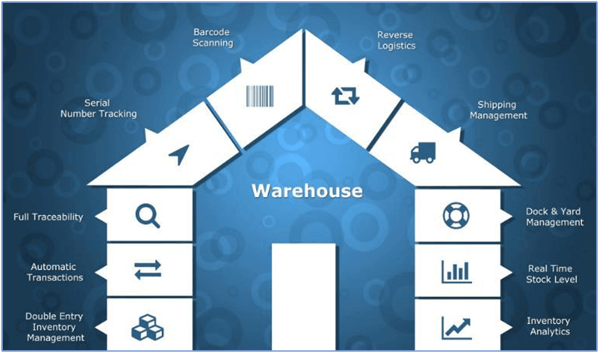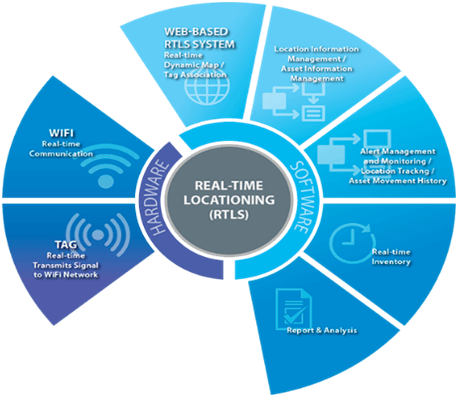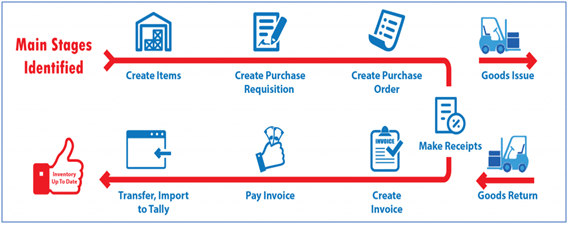Logistics system is a supply chain management component that is used to meet customer demands through the planning, control and implementation of the effective movement and storage of related information, goods and services from origin to destination. Logistics management helps companies to reduce expenses and improve customer service.
Table of Contents
Warehousing
Warehousing is a subset of logistics, warehouse is the safe and economical storage of goods, inventory, information, etc., within a specified area or building. Warehouses enable to carry on production all through the year and sell the products at any time there is sufficient demand.
Warehouse keeping operations costs to a minimum is a top priority for most business owners as strategize to reach maximum profit margins. However, warehousing remains a critically important part of the business logistics system.

Warehouse Management System
Warehouse Management System (WMS) is important parts of logistics, it helps to control and manage the day-to-day operations in a warehouse. It also can provide a solid foundation of industry best practices for receiving, put-away, inventory management, order processing, replenishment, picking / packing as well as loading and shipping.
Warehouse management system can reduce the likelihood of errors that could occur when a product is shipped and help a company fulfil orders more rapidly and instantaneously trace ordered products within the warehouse.
Although a WMS is complex and expensive to implement and run, organizations succeed benefits that can justify following:
- Improved Access of Information
- Improved Insight
- Improved Agility
- Better Collaborations
- Improved Productivity
- Improved Accuracy
- Reduced Training Time
Transportation Management System
Transportation Management System can help companies and supply chain professionals manage the freight and carriers.
Transportation Management System also can help user to find the best mode and rate for any type of shipment to make sure that getting the best deal possible. The main features of a Transportation Management System include features like rating, booking and tracking.
Transportation Management System also allowing to automate order entry, create shipments, optimize shipments and routes, manage carriers, schedule pickups and deliveries, manage the yard and communicate effectively with all supply chain stakeholders.
A fully deployed transportation management system can benefit organizations the following ways:
- Carrier contract management
- Risk management
- International logistics functionality
- Item visibility
- Parcel shipping support
- Freight settlement
- Business intelligence
- Benchmark data capability
A key activity is to provide for the movement of materials and goods from point of origin to point of consumption. Transportation involves selection of the mode (e.g., air, rail, water, truck, or pipeline), the routing of the shipment.

Real-Time Location System
Real time location systems are technology driven systems that use tags and readers to identify, find, track, and manage the location of assets or people in real-time, generally within a confined area.
Advantages of Real time location systems include accuracy, increased productivity, and operational excellence to track desired objects. Real time location systems also provide some additional benefits, such as improvement in safety and security of staff, efficient and effective logistic and supply chain operations, and smooth process operations.
The most common example of Real time location systems is GPS, which can make it easy to find the destination in a foreign country on a way the road never seen before. However, GPS doesn’t work indoors, so all the tracking and location functionality that GPS provides suddenly disappears when stepping into a building.
Communication also part of real time system becoming increasingly automated, multiple, and rapid. Logistics interfaces with a wide range of functions and organizations in its communication processes.
The communication must occur between:
1. The organization and its suppliers and customers
2. The major functions within the organization, such as logistics, procurement, engineering, account marketing and production.
3. The difference logistics activities listed previous and aspects of each activity such as coordinating warehousing of material, work in process and finished goods.
4. Various members of the supply chain, such as intermediaries and secondary customers or suppliers who may not be directly linked to the firm.
Communication is a key to the efficient functioning to all system, whether it be the distribution system of an organization or the wider supply chain.

Inventory Management System
Inventory management systems is track goods through the entire supply chain or the portion of business operation. That covers everything from production to retail, warehousing to shipping, and all the movements of stock and parts between.
Practically, it means a business can see all the small moving parts of its operations, allowing it to make better decisions and investments. Different inventory managers focus on different parts of the supply chain though small businesses are usually more interested in the ordering and sales end of the chain.
It is important to control the inbound and outbound of inventory to minimize losses and maximize profits, regardless of the system following:
1. Customer Satisfaction
Good inventory management leads to orders being fulfilled more quickly and shipped out to customers faster. The enhanced processes can help e-Commerce and online retail brands build a strong reaction with consumers.
2. Better Inventory Planning and Ordering
Detailed inventory management can be mitigating the issue, allowing warehouse to refresh inventory not only when needed. It is also both space and cost-effective.
3. Accurate Order Fulfilment
Inventory control system is important because it help keep an accurate record of stock levels. The systems will tell exactly how much in stock, which stock no longer have and which products need to re-order.

Reverse Logistics
Reverse logistics has become even more important with the arrival of the e-Commerce. This rapid growth in the volume of returns causes huge uncertainties around reverse logistics and puts pressure on supply chains to manage and implement product returns successfully. Reverse logistics in e-Commerce are reality of online retail.
As the depth of online product categories became apparent in the last three years, the importance of setting up a reverse logistics process as part of e-Commerce logistics strategy increases as well. Provide a bad returns experience and without a doubt reduce the chance of a customer coming back for a repeat purchase.
There are many reasons customers return products, including:
- The customer bought the wrong product
- The product was damaged upon arrival
- The product did not match its description
- The customer no longer wants the product
In these cases, organize shipping of the returned product and send it through various processes such as testing, dismantling, repairing, recycling or disposing of it. All these processes require the product travel in reverse through supply chain network.
Conclusion
Logistics management system continue to improvement in overall efficiency in integrated logistics. Logistics activities will play an ongoing and important role in determining whether a customer receives the right product, at the right place, in the right condition, at the right cost, and at the right time. Managing the difference activities as an integrated system must lead not only to the maximise of customer satisfaction, but also to the lowest possible total cost. In this way logistics management can contribute importantly to overall company efficiency, competitive advantage and profitability.
References
Alagappan Dasarathy, DLSM. (2018). “Integrating Warehousing and Transport Functions for EPC Project”. Retrieved from https://publication.sipmm.edu.sg/integrating-warehousing-transport-functions-epc-projects/, accessed 15/12/2018.
Andrew Marder. (2017). “What Is an Inventory Management System, and What Features Do I Need?”. Retrieved from https://blog.capterra.com/what-is-an-inventory-management-system/, accessed 19/12/2018.
Barley Li. (2017). “Real Time Location System (RTLS)”. Retrieved from https://www.digikey.com/en/blog/real-time-location-system, accessed 16/12/2018.
Cristian Grossmann. (2018). “3 Key Communication Challenges for Logistics Companies”. Retrieved from https://blog.beekeeper.io/3-key-communication-challenges-for-logistics-companies/, accessed 17/12/2018.
Iman Niroomand. (2017). “The importance of reverse logistics in your supply chain network”. Retrieved from https://blog.kinaxis.com/2017/09/importance-reverse-logistics-supply-chain-network/, accessed 17/12/2018.
PLS Logistics. (2018). “Benefits of a Transportation Management System (TMS)”. Retrieved from http://info.plslogistics.com/blog/benefits-of-a-transportation-management-system-tms, accessed 15/12/2018.
Sonia Lai Jie Yin, DLSM. (2018). “Key Success Factors for Effective Logistics Practices”. Retrieved from https://publication.sipmm.edu.sg/key-success-factors-effective-logistics-practices/, accessed 15/12/2018.

